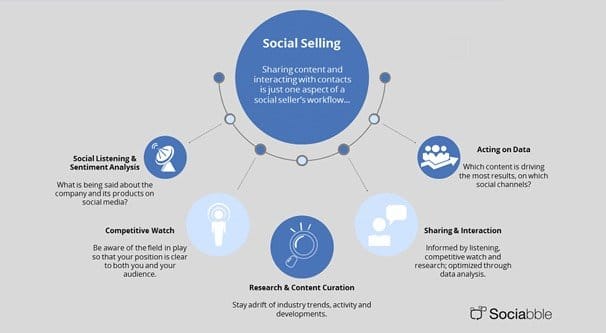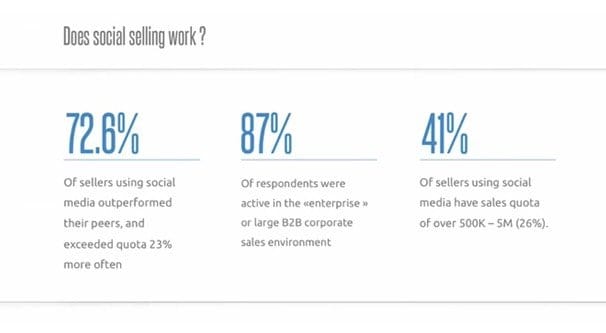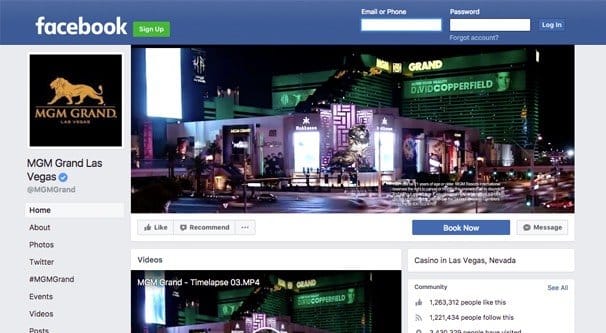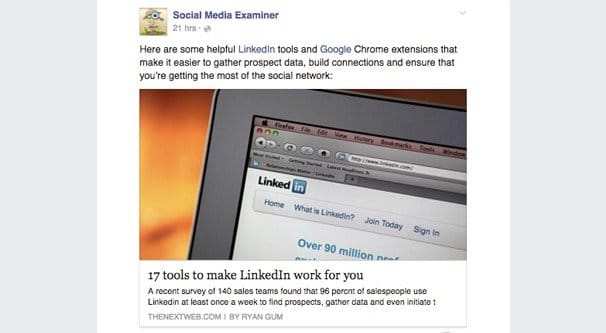 Written by ContentPowered.com
Written by ContentPowered.com
Social selling is to a certain extent one of those hot new marketing buzzwords that really doesn’t add much without knowing what it means. It represents a very real thing, and is simply a keyword for a process you may or may not know exists. People who know about it and who implement it have definably out-performed people with older selling methods, so it’s certainly here to stay.
Data from a study performed by Forrester and commissioned by HootSuite earlier this year surveyed 265 sales and marketing leaders. They found that 49% of B2B companies have developed formalized social selling programs, and 28% are in the process of doing so. All but two respondents at least planned to do so, and I’d wager that those two will be feeling the burn within a year.
So What Even Is Social Selling?
Social selling is essentially leveraging all of the varied benefits of social media for your sales process. I don’t mean just marketing via Facebook, though. I mean using social media to find new customers, connect with existing customers, understand your customers on a deep level, and nurture possible sales prospects. It’s also a way of keeping your brand at the forefront of your followers’ minds, so that when they have need of your product, you’re the first brand thing think of.
If you have social media profiles in active use, then, you’re already using the basics of social selling. Actual “Social selling” then is simply a more codified, intentional process than haphazard social media usage.
It’s all about using social media properly. Brands that shoot off automated DMs on Twitter, who post a dozen times a day on Facebook, who automate follower churn or who abuse black hat techniques are not using social selling. They’re spamming, they’re breaking rules, and they’re wasting time.
Social selling is not just focused on building up a mailing list; it’s about building up relationships. You want your customers to know your brand as more than just a brand, but as a leader in your industry, as a resource for information and service, and as an avenue through which they can solve problems. More importantly, you want to get to know your audience on a detailed level. Who they are, where they are, what they want and what they don’t want, how you can reach them; it’s all elements of social selling.
Why Your Brand Needs Social Selling
Take a look at your cell phone call history. How many times in the last month have you received a spam call? I’ve had weeks go by without one, but more than likely I’ll get one or two every week. At this point, if a number isn’t in my contact list, there’s a pretty good chance I’m not going to answer it.
If your brand bought a list of contacts who might be interested in your product, and you set your sales team to cold-calling those prospects, what do you think the reaction would be? I would venture to guess you have a very low rate of getting anyone to even listen to your pitch, let alone convert. This holds true even if you’re a B2B company; 90% of decision-makers for businesses say they never respond to cold calls.
Social selling doesn’t just get you leads; it gets you warm leads, people who are welcome to the idea of getting your product, or even people who are ready to seek you out on their own. Not only is your foot already in the door, some of them are actively opening the door and inviting you in.
Another core benefit of social selling is the networking effect. When people have a strong relationship with your brand, they’ll recommend you to their friends, family, and business partners. It’s the difference between going up to a random house and asking to see the head of the house with your vacuum in tow, and being invited to the address by the head of the house because their friend told them your vacuums are great.
On top of all of this, well, a lot of other brands – including your competitors – are already using social selling. People in general are used to social buying, it’s simply easier and more formalized than it used to be. Word of mouth has always been a powerful selling tool, but with social media it’s insanely easy to gain and spread that word of mouth. Where one person with a positive opinion might have been able to tell five or six of their friends before, they can post on Twitter and reach hundreds or thousands of people now. Every person can be a – albeit minor – celebrity endorsement, in a sense.
Positioning yourself as a social thought leader for your industry – one of the influencers, the sources of content, the Big Names – means that B2B buyers are much more likely to be willing to engage with your sales team. You establish a reputation as a provider of value, and that extends to your products or services.
One important aspect of social selling is the idea of ongoing support and service. Yes, many companies provide customer service, but being active and available through social media means you can speak to people through their channels, rather than forcing them through yours. Ongoing social connections with current and past clients and customers can lead to future sales and renewals. Providing unique and timely insight as well as support keeps people coming back.
How to Properly Sell Socially
There are not a lot of hard and fast rules for social selling, simply a collection of best practices learned through the mutual adaptation of users to brand actions and brands to user actions. In other words, you learn and change and grow as you go. You’ll make some mistakes no matter what list of rules you follow, but you might also stumble upon an innovation that either works uniquely for you or could expand the techniques used by your entire industry.
That said, there’s no need to go about reinventing the wheel with social selling. Build upon the foundation laid by other brands and marketers. That’s what the tips I’ve accumulated are all about.
#1: When building a social presence, make sure it’s an actual presence, not an absence. A large part of social media is posting content every day and responding to people who engage with that content. This can be a time-consuming process, so people are often tempted to automated large parts of it. Automation definitely has a role it can play in social media, but when it comes to responding to engagement, it’s definitely not worthwhile.
Be present and available. Facebook, for example, rates brand pages on the time it takes for them to respond to a message. You want that little entry to say something like “typically responds within minutes.” You definitely don’t want “rarely responds to messages.”
It’s easy when it comes to posting content. When you post a new blog post or share a new piece of content, hang around for an hour or so and respond to comments when people make them. You don’t need to say much to a “thanks for posting” kind of comment, but you can gain a lot of value out of just thanking people for their compliments, as well as responding to questions and engaging in discussions. After the first hour or so, you can set notifications or an alarm and check back when something happens.
As far as messages go, you should have some sort of notification available. You should also have someone on staff during business hours, if not around the clock, to deal with customer support issues. The exact availability depends on your budget to hire such an employee and the size of your business, which determines whether or not you need such service.
#2: Make sure you’re visible on social profiles when potential customers might seek you out. Look at your profiles from the point of view of a customer. They aren’t going to scroll back a few months in your feed to find out what you sell or what your website is. They want you to look credible, they want you to provide valuable insights, and they want common information – like site address, street address, contact information, hours, etc – to be visible as much as the social network allows. You obviously can’t put all that information on a site like Twitter, but one like Facebook or LinkedIn has forms specifically for most of that information. Fill out everything as much as possible.
It’s worth noting here that an active profile trumps two less-active profiles. It’s generally better to only create and optimize profiles for social networks you’re actually planning to use. When a new social network hits the scene, it tends to make a stir, like Ello did; hesitate before you dive in unless you’re sure you can stick with it, or that being an early adopter is going to benefit you. You want people to find you in a way they can actually find YOU, not a sign that just points to where you used to be.
It can also be worthwhile to pay some attention to social SEO. When you do a Google search for your brand name or your product, what comes up? Ideally your website should be first, but you also want your primary social profiles to be on the list.
#3: Pay attention to your customers, your potential customers, your audience, your competitors’ followers, and any other informational stream you can find. These people are sharing information about their wants, needs, and pain points. Some are whining about missing features or products that suck. Some are mentioning recommendations for new products or features. Some are just talking about problems they have, that maybe you could solve.
Keep an eye out for people who are either asking for recommendations for products similar to yours, or who are talking about problems they have that your product can solve. When you find these people, go through a checklist.
- Have they ever been a customer before? It’s generally not a great idea to approach someone who cancelled their account with you and offer them your product as if they have never seen it before.
- Do you have any connections in common with this person? If so, you might be able to leverage the networking effect. Ask your mutual connection – if they’re not just another customer – for a recommendation. The foot in the door helps more than you might think.
- Make sure what you have to offer can actually help them. I’ve seen people talk about a specific problem that has a similar general case solved by a product, but not the specific case. If you can add the feature, do so; if not, don’t try to sell something you can’t do.
Most of the time you aren’t going to be able to sell right away, but you can get people to check out your website or landing page to see if they’re interested. Sometimes you get a new subscriber to your mailing list. Sometimes you get a new customer. Sometimes you just open a dialogue. Either way, it’s better than nothing.
#4: Fill your feeds with value. You can’t skate by just with sharing value from other sources. You need to share information, write tutorials, share content from influencers, and strive to become an influencer yourself.
There are a ton of guidelines and rules towards managing your feed and your blog for value. This little bullet point isn’t the place to get into all of them. The main thing you need to keep in mind is just that your posts should largely be helpful to your users, rather than sales pitches for your brand. When you’re helpful, people will investigate who you are and what you do. When you’re trying to sell to them, you’re like a commercial they skip in between the TV show they want to watch.
If all of this sounds familiar to you, well, good news; it’s not actually something new. If you’ve been working with social media for the last few years, you’re in a good position to keep it rolling. Now you just know the name for what you’re doing.




